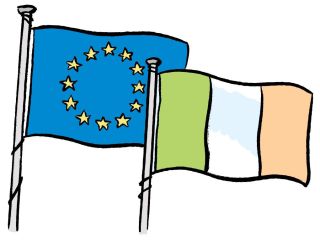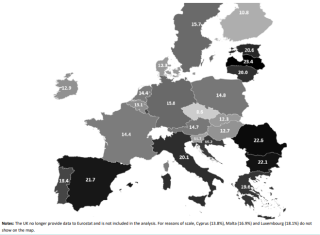Poverty: A European Perspective

Eurostat, the European Statistics Agency, produces comparable ‘at risk of poverty’ figures (proportions of the population living below the poverty line) for each EU member state. The data is calculated using the 60 per cent of median income poverty line in each country. Comparable EU‐wide definitions of income and equivalence scale are used ‐ note these slightly differ from national definitions. The latest data available for all member states is for the year 2021 when the average risk of poverty in the EU‐27 was 16.8 per cent. It is helpful to compare Irish measures of poverty with those elsewhere in Europe.
As chart 1 shows, Irish people experience a below average risk of poverty when compared to all other EU member states. Eurostat’s 2008 figures marked the first time Ireland’s poverty levels fell below average EU levels. This phenomenon was driven by sustained increases in welfare payments in the years prior to 2008. Ireland’s poverty levels have remained below average EU levels since then. In 2021, across the EU, the highest poverty levels were found in the recent accession countries and in some of the countries most impacted by the economic crisis one decade ago ‐ Latvia, Romania, Bulgaria, Spain, Estonia, Italy and Lithuania. The lowest levels were found in Czechia (formerly the Czech Republic), Finland, Slovenia, Slovakia and Denmark.
While there have been some reductions in poverty in recent years across the EU, the data suggests that poverty remains a large and ongoing EU‐wide problem. In 2021 the average EU‐27 level implied that 73.7 million people live in poverty across all EU member states. As part of the Europe 2020 Strategy, European governments adopted policies to target these poverty levels and used as their main benchmark the proportion of the population at risk of poverty or social exclusion. One of the five headline targets for this strategy aims to lift at least 20 million people out of the risk of poverty or exclusion by 2020 (using 2008 as the baseline year). This target is defined by the European Council on the basis of three indicators: the 'at risk of poverty' rate after social transfers; an index of material deprivation; and the percentage of people living in households with very low work intensity. It is calculated as the sum of persons relative to the national population who are at risk of poverty or severely materially deprived or living in households with very low work intensity, where a person is only counted once even if recorded in more than one indicator.
Since 2011 Social Justice Ireland has published regular reports analysing performance vis a vis these Europe 2020 goals. The most recent data indicate that by the end of 2019 (just before the pandemic struck) there had been limited progress towards the 2020 target. Missing this headline target poses a challenge for European policy makers, one side‐lined in the short term as the energy crisis and Ukraine war dominate. However, new commitments matched by actions, funding and progress are badly needed.
Chart 1: Poverty Rates Across the EU Countries, 2021 (Eurostat data)

Social Justice Ireland believes that it should be a national priority to provide all with sufficient income to live life with dignity. This would require enough income to provide a minimum floor of social and economic resources in such a way as to ensure that no person in Ireland falls below the threshold of social provision necessary to enable him or her to participate in activities that are considered the norm for society generally. If poverty rates are to fall further in the years ahead, Social Justice Ireland believes that the following are required:
- increase in social welfare payments
- equity of social welfare rates
- adequate payments for children
- refundable tax credits
- decent rates of pay for low paid workers
- a universal state pension
- a cost of disability payment
Social Justice Ireland believes that in the period ahead Government and policy‐makers generally should:
- Immediately provide for an additional €8 per week (€20 in total) in core social welfare rates in the Social Welfare Bill 2022
- Acknowledge that Ireland has an on‐going poverty problem
- Adopt targets aimed at reducing poverty among particular vulnerable groups such as children, lone parents, jobless households and those in social rented housing
- Examine and support viable, alternative policy options aimed at giving priority to protecting vulnerable sectors of society
- Carry out in‐depth social impact assessments prior to implementing proposed policy initiatives that impact on the income and public services that many low income households depend on. This should include the poverty‐proofing of all public policy initiatives
- Recognise the problem of the ‘working poor’. Make tax credits refundable to address the situation of households in poverty which are headed by a person with a job
- Support the widespread adoption of a Living Wage so that low paid workers receive an adequate income and can afford a minimum, but decent, standard of living
- Introduce a cost of disability allowance to address the poverty and social exclusion of people with a long‐term illness or disability
- Recognise the reality of poverty among migrants and adopt policies to assist this group. Including the full implementation of the White Paper on the Elimination of Direct Provision
- Accept that persistent poverty should be used as the primary indicator of poverty measurement and assist the CSO in allocating sufficient resources to collect this data
- Introduce a universal basic income system. No other approach has the capacity to ensure all members of society have sufficient income to live life with dignity
- Acknowledge the failure to meet repeated policy targets on poverty reduction and commit sufficient resources to achieve credible new targets.